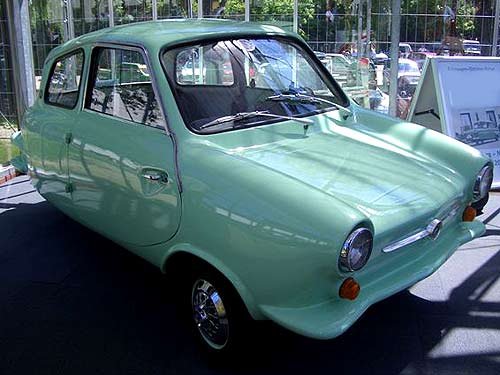The streets of 1960s Athens buzzed with the distinctive hum of a unique three-wheeler. The Alta A200, a compact marvel of Greek engineering, navigated narrow alleys with surprising grace. This wasn’t just another microcar – it represented Greek industrial ambition in automotive form.
Through the decades, this diminutive vehicle has transformed from an economical transport solution into a cherished collector’s piece. Each surviving A200 tells a story of Mediterranean ingenuity and practical design that continues to captivate automotive enthusiasts worldwide.
The Birth of a Greek Legend
Alta’s journey into automotive history began in 1962, when the company first established its manufacturing facilities in Greece. The company initially focused on motorcycles and small trucks, building expertise that would later shape the A200’s development. By 1968, Alta had refined its vision into the A200 model, combining the maneuverability of a motorcycle with the comfort of a car.
The economic climate of 1960s Greece shaped the A200’s creation. Post-war reconstruction and urbanization created demand for affordable personal transportation. Alta responded with a vehicle that balanced cost-effectiveness with practical features.
Historical Reference!
During the 1960s, Greece experienced a 7% annual economic growth rate, creating a new middle class eager for affordable transportation solutions. The Alta A200 emerged as a direct response to this societal transformation.
“The Alta A200 represented a crucial moment in Greek industrial development,” notes Dr. Andreas Papadopoulos, automotive historian at the University of Athens. “It demonstrated that Greece could compete in vehicle manufacturing, albeit in a specialized niche.”
The company’s focus on practical innovation and local market understanding proved crucial to the A200’s initial success.
Technical Marvel in Miniature
The A200’s technical specifications reveal thoughtful engineering within compact dimensions. At its heart, the 198cc Heinkel engine delivered 10 horsepower through a four-speed manual transmission. While modest by today’s standards, this powerplant provided adequate performance for urban use.
Key technical specifications include:
- engine displacement: 198cc (12.1 cui);
- power output: 7.5 kW (10 hp);
- transmission: 4-speed manual;
- drive configuration: rear-wheel drive;
- dimensions: 3150x1450x1350 mm;
- wheelbase: 2100 mm.
The vehicle’s three-wheel configuration wasn’t merely a design choice – it reflected clever regulatory compliance. Under Greek law, this setup allowed the A200 to be classified differently from four-wheeled cars, offering tax and licensing advantages.
“The A200’s engineering represents elegant simplicity,” explains Michael Stavros, vintage microcar restorer. “Every component serves a purpose, making maintenance straightforward and reliability excellent for its era.”
Design and Practicality
Alta’s designers prioritized practical functionality in the A200. The enclosed two-door sedan body protected occupants from weather while maintaining easy access. Despite its compact exterior dimensions, the cabin accommodated two adults comfortably, with space for essential cargo.
Fact!
The Alta A200's body design achieved a remarkable balance of aerodynamics and practicality, with its teardrop-shaped rear section reducing drag while maximizing interior space.
“Our family A200 served reliably for over a decade,” recalls Maria Konstantinou, whose father purchased one new in 1969. “It became part of our daily life, taking us to markets, schools, and weekend excursions with remarkable economy.”
The vehicle’s light weight and tight turning radius made it exceptionally maneuverable in crowded urban environments. Its design emphasized visibility, with large windows and minimal blind spots.
The interior layout focused on simplicity and durability, with basic yet functional instrumentation and controls placed within easy reach.
Legacy and Collection Value
Today, the Alta A200 holds a special place in automotive history. Surviving examples have become prized collectibles, particularly in Greece where they represent an important chapter in national industrial heritage.
Recent years have seen increased interest from international collectors. In 2025, a family-owned 1968 model attracted attention from collectors worldwide, highlighting the A200’s growing recognition in classic car circles.
The vehicle’s rarity enhances its appeal – exact production numbers remain unclear, but surviving examples number in the dozens rather than hundreds. Each preserved A200 serves as a testament to Greek automotive innovation.
Important!
The Alta A200's value as a collectible has risen significantly in recent years, with well-preserved examples now considered important artifacts of European microcar history.
Preservation efforts have intensified as enthusiasts recognize the A200’s historical significance. Owner clubs and restoration specialists work to maintain existing vehicles and document their history.
Beyond Transportation
The Alta A200 transcends its role as mere transportation. It embodies a pivotal moment in Greek industrial history, when local manufacturers dared to compete in the international automotive market.
This compact three-wheeler reminds us that innovation often emerges from practical necessity. Its legacy lives on through preserved examples and the stories of those who drove them, marking the Alta A200 as more than a microcar – it’s a piece of Mediterranean automotive heritage.
Pros and Cons
| Advantages | Disadvantages |
|---|---|
| Exceptional maneuverability in urban environments | Limited power output (10 hp) |
| Weather protection unlike contemporary motorcycles | Restricted passenger capacity |
| Tax and licensing advantages due to three-wheel design | Minimal cargo space |
| Simple, reliable mechanical design | Limited top speed |
| Historical significance as Greek-manufactured vehicle | Sparse parts availability today |
| Strong collector value potential | Three-wheel stability concerns |
| Economical operation | Basic comfort features |
The Alta A200 represents a fascinating chapter in automotive history, particularly for collectors and enthusiasts interested in unique European microcars. While its limitations are clear from a modern perspective, they’re offset by its historical significance and charm. Its growing recognition in collector circles suggests that this humble Greek three-wheeler will continue to captivate automotive enthusiasts for generations to come.

